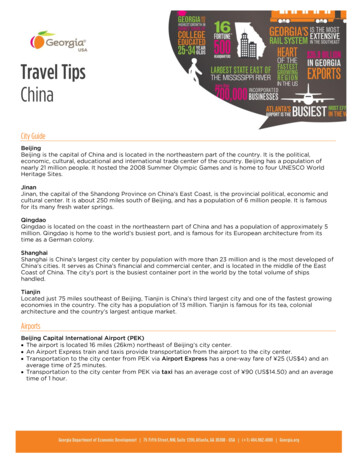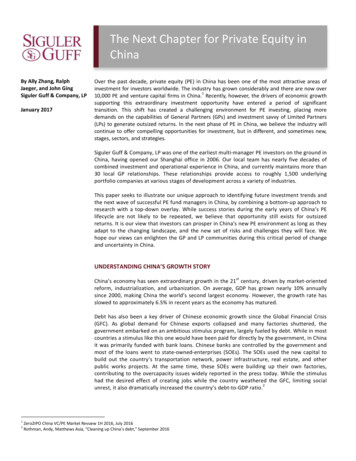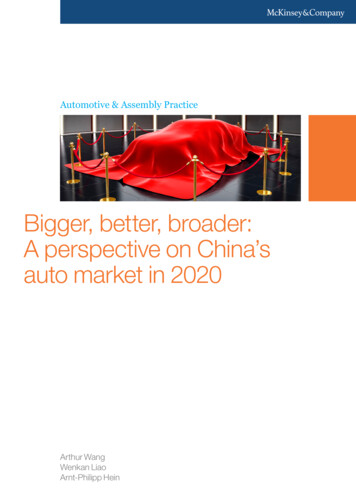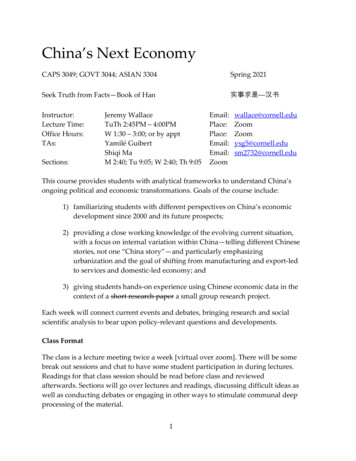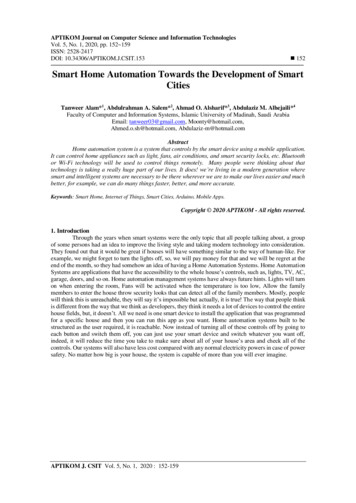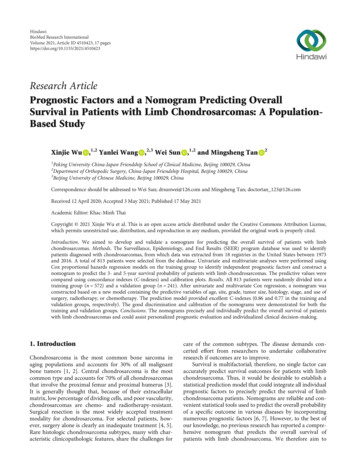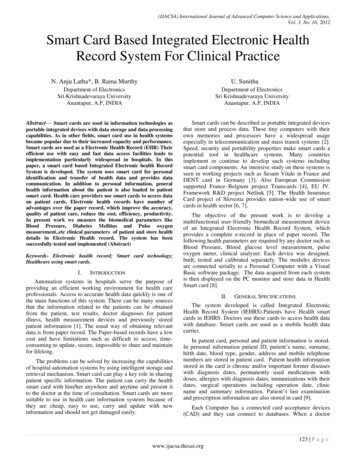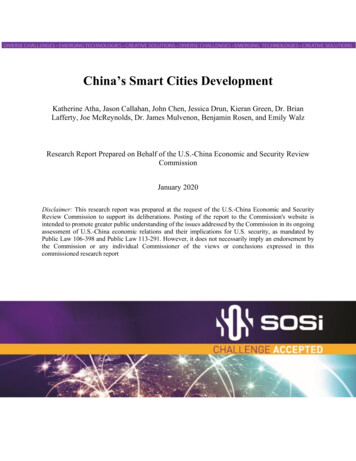
Transcription
China’s Smart Cities DevelopmentKatherine Atha, Jason Callahan, John Chen, Jessica Drun, Kieran Green, Dr. BrianLafferty, Joe McReynolds, Dr. James Mulvenon, Benjamin Rosen, and Emily WalzResearch Report Prepared on Behalf of the U.S.-China Economic and Security ReviewCommissionJanuary 2020Disclaimer: This research report was prepared at the request of the U.S.-China Economic and SecurityReview Commission to support its deliberations. Posting of the report to the Commission's website isintended to promote greater public understanding of the issues addressed by the Commission in its ongoingassessment of U.S.-China economic relations and their implications for U.S. security, as mandated byPublic Law 106-398 and Public Law 113-291. However, it does not necessarily imply an endorsement bythe Commission or any individual Commissioner of the views or conclusions expressed in thiscommissioned research report
About SOSiSOS International LLC (SOSi) is a leading provider of intelligence, technology, and projectmanagement solutions to large government and private sector organizations around the world. Wedeliver a wide range of services that support the national security interests of the U.S., the securityand stability of its allies, and the interests of large, multinational corporations in the defense, oil,gas, mining, construction and manufacturing sectors.This project was conducted within SOSi’s Intelligence Solutions Group, a premier open sourceand intelligence exploitation cell for the U.S. intelligence community, Department of Defense, andFederal law enforcement. Staffed by an experienced team of cleared analysts with advancedlanguage skills, SOSi’s mission is to provide cutting-edge, open source intelligence support to thecollection, analytical, and operational activities of the U.S. Government, with the goal of achievingnational strategic objectives. SOSi accomplishes its mission through the conduct of objective,independent, and relevant research and analysis, under strict quality guidelines.Comments may be sent to Dr. James Mulvenon.Dr. James MulvenonSpecial Programs DivisionSOS International2650 Park Tower Drive, Suite 300Vienna, VA 22180TEL: 571-421-8359Email: James.Mulvenon@sosi.comi
AcronymsAcronymFull EIGFIoTIPISOITITAITANITSITU3rd Generation Partnership ProjectAsian Development Bankartificial intelligenceadvanced metering infrastructureAsia Reassurance Initiative ActAssociation of Southeast Asian NationsBetter Utilization of Investments Leading to DevelopmentBelt and Road InitiativeCybersecurity Administration of ChinaChina Academy of Information and Communications TechnologyChina Aerospace Science and Technology Corporation LimitedChina Aerospace Science and Industry CorporationChina Electronic Information Industry DevelopmentChinese Communist Partyclosed-circuit televisionChina Electronics CorporationChina National Electronics Import & Export CorporationChina Electronics Technology Group Co., Ltd.Division for International Communications and Information Policy, U.S. Department of StateCybersecurity and Infrastructure Security Agency, U.S. Department of Homeland SecurityChinese National Vulnerability DatabaseChina Road and Bridge CorporationChina Railway Rolling Stock CorporationCommon Vulnerabilities and ExposuresU.S. International Development Finance CorporationU.S. Department of Homeland SecurityU.S. Department of Defensedigital video recorderEuropean UnionFederal Communications Commissionforeign direct investmentFive Year Planvoluntary national standardGlobal City Teams ChallengeGeographic Information SystemsGlobal Positioning SystemsHuawei Cyber Security Evaluation Centreindustrial control systemsinformation and communications technologyInternational Electrotechnical CommissionInstitute of Electrical and Electronics EngineersInternet Governance ForumInternet of Thingsinternet protocolInternational Organization for Standardizationinformation technologyU.S. International Trade AdministrationInfrastructure Transaction and Assistance Networkintelligent transportation systemsInternational Telecommunication Unionii
UKUNJoint Technical Commissionlong-term evolutionChina’s Ministry of Industry and Information TechnologyMassachusetts Institute of TechnologyMinistry of Housing and Urban-Rural DevelopmentChina’s Ministry of Science and TechnologyChina’s Ministry of TransportationMemorandum of UnderstandingChina’s Ministry of Public SecurityChina’s Ministry of State SecurityNarrowband Internet of ThingsChina’s National Development and Reform CommissionU.S. National Institute of Standards and TechnologyNational Science FoundationNational New-type Urbanization Plan 2014-2020network video recorderon-board diagnosticsU.S. Overseas Private Investment CorporationPresident’s Council of Advisors on Science and TechnologyPeople’s Liberation Armypublic-private partnershipPeople’s Republic of Chinaresearch and developmentradio frequency identificationrenminbiremote sensingStandardization Administration of Chinaspecial economic zonetactics, techniques, and proceduresUnited KingdomUnited Nationsiii
Table of ContentsAbout SOSi . iAcronyms . iiTable of Contents . ivExecutive Summary and Key Findings . 1Key Findings . 2Chinese Smart Cities Policies . 2Chinese Smart Cities Development Trends . 2Chinese Surveillance . 2Chinese Promotion of Smart Cities Technologies Abroad . 3Smart Cities in the Context of U.S.-China Relations. 4Recommendations . 4Introduction . 7I Chinese Smart Cities Policies: History and Current Practice . 12Key Findings . 12Smart Cities Initiatives in Historical and Procedural Context . 12The Path to New Smart Cities. 14Xi’s Increasing Smart Cities Emphasis. 16Xi’s Focus on the Xiong’an New Area . 17Current Smart Cities Policy and the Chinese Regulatory State . 18II Chinese Smart Cities Development Trends. 24Key Findings . 24Government-led Smart Cities Development . 25The Geography of Smart City Pilots. 26Smart Cities Goals: Public Services, Management Efficiency, and Economic Development. 27Growth in Key Technologies: The IoT, Big Data, and the Cloud . 32Coordinating Governance and Management: Leading Small Groups and Big DataManagement Administrations, and National and International Connections . 35Commercial Enterprise Involvement . 37Successes to Date, Challenges Ahead . 39III “The Masses Have Sharp Eyes:” Technology and Mass Surveillance in Chinese Smart Cities. 43Key Findings . 43The Evolution of Mass Surveillance in the People’s Republic of China . 44Smart City Improvements for Mass Surveillance . 47Chinese Mass Surveillance in an International Context . 52IV China’s Export of Smart Cities . 55Key Findings . 55Taking Smart Cities Abroad: The Belt and Road Initiative, State-Backed Financing, andInternational Standards Organizations . 56Methodology and Study Limitations . 58Identified Smart City Technology Exports . 60Case Study: Smart City Platforms in Malaysia. 62Case Study: Integrated Security Platforms in Ecuador . 65iv
Case Study: Surveillance and Smart Payment Systems in Kenya . 67Case Study: Investment and Innovation in Germany . 71Case Study: Infrastructure and Security Cameras in the United Kingdom . 74Future Plans and Trajectories. 78Implications for the United States. 79V Smart Cities and U.S.-China Relations . 81Key Findings: . 81U.S. Smart Cities: A Big-Picture, Bottom-Up Approach . 81U.S. Smart Cities Initiatives Abroad and the Indo-Pacific Strategy . 86Comparing Chinese and U.S. Smart City Development . 88Comparing Cities . 89Comparing Constituent Technologies. 90Comparing Company Market Power . 91Securing Smart Cities in the United States . 95Determining Vulnerabilities in Smart Cities. 97Managing Supply Chain Risk: Huawei and the United States . 98Chinese Smart City Technologies in the United States . 100Chinese Imports to the United States . 101U.S. Reliance on Chinese Imports . 102Beyond Imports: Foreign Direct Investment, Joint Ventures, and Policy Capture . 106Implications for the United States . 109Global Competitiveness . 109National Security Risks and Responses . 111Conclusions and Areas for Future Research . 113v
Executive Summary and Key FindingsAround the world, countries and cities chasing improved resource allocation, increased efficiency,enhanced public safety, and sustainable growth are turning to a range of networked technologiesto help manage everything from government services to traffic patterns. The collective term forthese technology solutions has become “smart cities,” first coined in the 1990s but re-introducedwith its current meaning by IBM in 2008. Smart cities can refer to an entire urban ecosystememploying smart cities principles or to the constituent technologies and applications that make upthat ecosystem. While there is no standard list of “smart cities” technologies and applications, atits core, the term signifies the use of digital technology to collect and share data about municipaloperations that had been previously unavailable or disaggregated, allowing for improvedmunicipal management and services. Successful development and deployment of smart citiestechnologies is likely to have major social and economic impacts as massive amounts of data arecollected and used to improve efficiency in daily life and optimize or automate previouslyburdensome or inefficient governance tasks.China has become a global leader in smart cities initiatives, combining embedded sensors,metering devices, cameras, and other monitoring technologies with big data processing andartificial intelligence (AI) analysis to help manage its cities and public spaces. Its leadership hasclearly signaled the importance of smart cities development, elevating it to a national strategy, andhas poured government resources into furthering its growth. China reportedly has nearly 800 smartcities pilot programs underway or in planning, which would be more than half of the total smartcities around the world. As China’s state-run news service Xinhua recently editorialized, Chinabelieves it will win “the global race toward building an intelligent and data-driven society.”While the improvement of municipal infrastructure is ostensibly benign, the pace, scale, andapplication of China’s smart cities development poses new and substantive challenges to U.S.interests at home and abroad. U.S. support for global smart cities development is tied to broaderforeign policy initiatives intended to bolster support for a values-led system and offer an alternativeto authoritarian development models. While the United States is itself a world leader in developingsmart cities technologies, its sustained position is by no means guaranteed, particularly given howaggressively and successfully China has advanced in these areas.Moreover, how countries use the data that smart cities platforms collect is a concern. Technologiesthat by definition capture and synthesize massive amounts of real-world, real-time data on people’sdaily lives can easily be deployed in a manner that threatens personal privacy or even nationalsecurity. This is a concern for the United States and other countries considering the risks ofincluding Chinese technologies in their critical infrastructure. China is actively promoting its smartcities solutions abroad via the Belt and Road Initiative’s technology engagement policies, makinga thorough understanding of these potential risks especially timely.This report seeks to answer the following research questions. First, it focuses on the policies theChinese government has enacted to promote smart cities and China’s progress in implementingsmart cities and key enabling technologies, particularly with respect to mass surveillance. Second,the report describes China’s efforts to promote its smart cities technologies abroad and thepotential impact of this promotion. Finally, the report compares the state of smart citiesdevelopment in China and the United States, identifies potential risks to and vulnerabilities in U.S.critical infrastructure stemming from the use of Chinese products, and describes the implicationsof China’s smart cities development for U.S. national security and global competitiveness.1
The research for this report relied on Chinese and English language sources, including governmentannouncements, academic papers, news items, and industry reports.Key FindingsIn order to better inform the U.S. government and Congress as they assess how to secure U.S.economic and security interests vis-à-vis Chinese smart cities plans, this report identifies a numberof key findings:Chinese Smart Cities Policies Smart cities are part of a decades-long pattern of Chinese government programs that seekto digitize and “informatize” cities to improve China’s comprehensive national power andinternal strength. The central government’s top-down approach to smart cities pilot programs and shift awayfrom city-led initiatives has led to the centralization of decision-making and thedecentralization of implementation. This has resulted in a nonlinear and unpredictabledevelopment trajectory for Chinese smart cities that allows for course-correction andexperimentation. Chinese smart cities policies have begun to coalesce and standardize after an initial periodof experimentation and bureaucratic overlap.Chinese Smart Cities Development Trends The development of Chinese smart cities technology is primarily top-down, driven bygovernment investment, and generally aligns with regional development patterns—withthe bulk of projects located in China’s more economically-developed eastern seaboard. Estimates of the size of the smart cities solutions market in China vary widely and theirreliability is somewhat unclear; Chinese consulting firms bullishly pegged the market atRMB 7.9 trillion ( 1.1 trillion) 1 in 2018 and projected a 33 percent compound annualgrowth rate between 2018 and 2022. Chinese municipal authorities charged with smart cities development commonly citetransportation, public services, public safety, education, healthcare, and environmentalprotection as focus areas for Chinese smart cities projects. While there are numerous noted examples of the successful deployment of smart citiessolutions in China, many challenges still exist, including long-term program sustainability,insufficient information-sharing mechanisms between governing authorities, and a dearthof accurate information about actual progress in smart city development funding andimplementation. Together, these deficiencies hinder a more widespread embrace of smartcities across the country.Chinese Surveillance Chinese government officials are embracing smart cities technologies—especially theInternet of Things (IoT), mobile internet, cloud computing, and big data—to expand,improve, and automate information collection and analysis for mass surveillance.1The exchange rate used in the report is RMB 7.14798 for every 1.2
Much of the implementation of this “smart surveillance” occurs at the local level, althoughlocal surveillance programs are increasingly tapping into national-level information andnetwork resources. Massive local implementation of smart cities surveillance has created difficulties inupgrading surveillance equipment and fostered a low degree of standardization andintegration for systems deployed in different regions and localities in China. Even as China embraces smart cities technologies to surveil its people, it continues to usevolunteers to monitor the actions of the general population and to augment smart citysurveillance. This practice of “mass defense, mass rule” (群防群治) is a continuation ofhistorical Chinese Communist Party (CCP) surveillance efforts that stands to benefitgreatly from increased use of smart cities technologies. China’s current mass surveillance efforts and the industry that supports them are some ofthe largest and most prolific in the world, but China’s future ambitions for domestic masssurveillance likely dwarf the size and scope of its current extensive surveillance state. TheCCP’s intent to deploy 626 million video cameras by 2020, widening adoption of artificialintelligence, and functionally nonexistent civil rights protections are laying thegroundwork for a digital panopticon.Chinese Promotion of Smart Cities Technologies Abroad Chinese technology companies have been successful in promoting and installing smartcities technologies around the world. Analysts identified 398 reported instances of 34different Chinese firms exporting smart cities technologies through involvement in smartcities development projects in a total of 106 countries. The Belt and Road Initiative (BRI), China’s signature foreign policy, highlights smart citiesas a “strategic opportunity” for Chinese firms to expand abroad. While these plans do notinclude specifics about future expansion, it is likely that smart city promotion as part of theBelt and Road Initiative will continue to be an international priority with backing from thehighest levels of the Chinese government. In developing nations, smart cities projects focused on installing surveillance technologiesand network infrastructure have been notable successes of Chinese national champions likeHuawei, often with the financial backing of state-owned banks like the Export-Import Bankof China. Chinese firms see more developed countries as valuable sources of technology andexpertise as well as markets for Chinese technology, frequently developing partnershipsand establishing joint laboratories in these countries. These partnerships are used in part topromote Chinese technology standards and expand access to advanced technology and inpart to improve international perceptions of Chinese firms. Though clear information on data sharing arrangements between Chinese technology firmsand local governments abroad could not be found, expanding access to global data sets toinclude these firms gives them a market advantage and may aid Chinese intelligencecollection efforts. Through all of these avenues, the growth of Chinese smart cities exports presents a seriouseconomic and security challenge to the United States.3
Smart Cities in the Context of U.S.-China Relations The United States government has adopted a bottom-up approach to smart citydevelopment that stands in contrast to China’s top-down model, taking a “convening”rather than a leading role and encouraging localized implementation, with a policy focuson security and privacy as “first order design principles.” The United States has tied its promotion of smart cities abroad to larger policy initiativesunder the Indo-Pacific strategy that emphasize a values-led system as an alternative toauthoritarian development models (namely, China’s BRI). Challenges in capturing and categorizing data make comparisons of U.S. and Chinesesmart cities technologies difficult, but evidence suggests that Chinese hardware is broadlyon par with U.S. products, while Chinese software lags behind U.S. offerings. What makes U.S. smart cities policies lasting and sustainable in the long run—the bottomup approach that leverages local skills and advantages—also makes these communitiesvulnerable to compromised technologies in city infrastructure and systems, Chinese orotherwise, as the focus has historically been more on local priorities and needs than aunified, national approach to privacy and security. While the U.S. government has taken some steps to secure ICT systems and supply chains,Chinese smart cities products are still in use across the United States, despite knownvulnerabilities and suspected potential for compromise through PRC legal mandatesrequiring Chinese firms to share information with their government.RecommendationsOn the basis of these key findings, the authors offer the following recommendations to ensureU.S. global competitiveness in overseas smart cities markets, safeguard U.S. national securityinterests at home and abroad, and protect the privacy of U.S. citizens:1) To better quantify the spread of foreign smart cities technologies in U.S. domesticsystems, encourage the creation of local and regional oversight task forces to collectmore accurate data, identify potential risks in foreign investment in domesticinfrastructure, and maintain an information-sharing mechanism between thesecommunities.One of the fundamental challenges identified in this report is the dearth of quantifiable knowledgeregarding the scope and nature of new smart cities technologies and the possible risks increasedglobal adoption of these technologies poses. The U.S. government must first characterize theinflow of foreign smart cities technologies, determining both volume and capabilities of smartcities products coming into the United States. Reports designated under U.S. Code Title 13 fromthe U.S. Census Bureau to Congress (in conjunction with the Bureau of Economic Analysis andU.S. Customs and Border Protection) could be modified to include specific reporting on smartcities technology imports, with these technologies prioritized according to U.S. national securityconcerns. The Bureau of Economic Analysis also reports on U.S. businesses with significantforeign investment, and these studies could be correlated with a list of U.S.-built smart citiestechnologies to capture the full range of potential security risk.The Department of Commerce, potentially in partnership with the Department of HomelandSecurity’s Cybersecurity and Infrastructure Security Agency (CISA), should work with state andlocal governments to establish a task force structure that includes input from stakeholders in4
government, academia, and industry. The task force should produce annual reports on smart citiesbest practices and risks. Alternatively, Commerce could commission a National Academies effortto convene the task force.This effort could be the first step in a process leading to some form of smart cities stimulus todevelop and apply smart city technologies. Stimulus money run through the Department ofCommerce’s Economic Development Administration would be tied to city and regional adherenceto best practices established by the task force reports, meeting local needs through the task forceprocess and removing the requirement for overly prescriptive regulation of technologies. Theresults of the task force reports could also inform the international efforts of the State Department’sDivision for International Communications and Information Policy (CIP) (outlined inRecommendation 3).2) To mitigate the global spread of Chinese smart cities technologies, support U.S.competitiveness in international smart cities markets.To achieve this goal, the U.S. government should pursue a two-track approach. In the short term,it should continue investing resources and personnel to support U.S. businesses in key regions suchas Southeast Asia and Africa to keep abreast of not only smart cities development trends, but alsoas an effort to outpace China in these markets. The State Department’s Bureau of Economic andBusiness Affairs should initiate studies of specific smart cities trends in these key regionsexamining market and investment indices. Congress should also consider tax incentives to U.S.businesses investing in key smart cities technologies, possibly through adjustments to the Researchand Experimentation Tax Credit, while the United States should incentivize nations in strategicregions to invest in U.S.-produced technologies, potentially with loan guarantees through the U.S.International Development Finance Corporation, the U.S. Export-Import Bank, or in coordinationwith treaty allies such as Japan and South Korea that are already investing in smart citiestechnologies for developing nations.In the long term, Washington should study demographic trends and identify future cities andregions likely to invest in smart cities technologies, particularly as China works to overcome issuesof market access. The Department of Commerce should initiate a series of workshops orroundtables with key U.S. tech sector companies, researchers, and other stakeholders (such as fromthe Institute of Electrical and Electronics Engineers (IEEE)) to determine what policies andinformation would be most useful for the U.S. private sector to compete in international smartcities technologies markets. The meetings should also involve Department of Defense andDepartment of Homeland Security personnel to highlight U.S. policy and best practices regardingthe national security implications of the rising influence of Chinese smart cities technologycompanies and could incorporate reporting from the task forc
China’s Smart Cities Development Katherine Atha, Jason Callahan, John Chen, Jessica Drun, Kieran Green, Dr. Brian Lafferty, Joe McReynolds, Dr. James Mulvenon, Benjamin Rose
